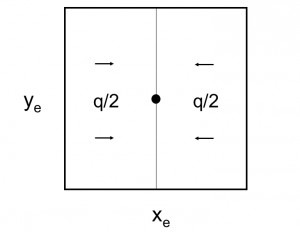Difference between revisions of "6/π stimulated well potential"
From wiki.pengtools.com
(→Math & Physics) |
|||
| Line 19: | Line 19: | ||
:<math> q/2 =\frac{dV}{dt}</math> | :<math> q/2 =\frac{dV}{dt}</math> | ||
| + | |||
| + | :<math>c=\frac{1}{V} \frac{dV}{dP}</math> | ||
:<math> V =y_e*h*x_e/2*\phi</math> | :<math> V =y_e*h*x_e/2*\phi</math> | ||
| − | |||
| − | |||
:<math> q/2 =c V\frac{dP}{dt} = c y_e h x_e/2 \phi \frac{dP}{dt}</math> | :<math> q/2 =c V\frac{dP}{dt} = c y_e h x_e/2 \phi \frac{dP}{dt}</math> | ||
Revision as of 10:46, 12 September 2018
Brief
6/π is the maximum possible stimulation potential for pseudo steady state linear flow in a square well spacing.
Math & Physics
Pseudo steady state flow boundary conditions:
From Diffusivity Equation:
 ( 1 )
( 1 )
From Material Balance:
 ( 2 )
( 2 )
( 2 ) - > ( 1 ) :
 ( 3 )
( 3 )
Integrating ( 3 ):
 must satisfy boundary condition:
must satisfy boundary condition: 
 ( 4 )
( 4 )
Integrating ( 4 ):
 ( 5 )
( 5 )
Since average pressure is:  :
:
See also
optiFrac
fracDesign
Production Potential
Nomenclature
 = cross-sectional area, cm2
= cross-sectional area, cm2 = thickness, m
= thickness, m = permeability, d
= permeability, d = pressure, atm
= pressure, atm = initial pressure, atm
= initial pressure, atm = average pressure, atm
= average pressure, atm = flow rate, cm3/sec
= flow rate, cm3/sec = length, m
= length, m = drinage area length, m
= drinage area length, m = drinage area width, m
= drinage area width, m
Greek symbols
 = oil viscosity, cp
= oil viscosity, cp











